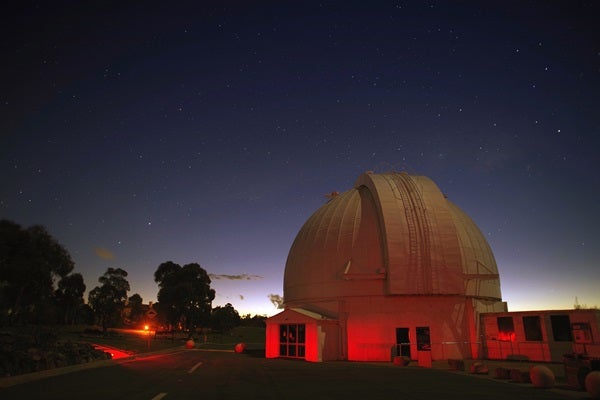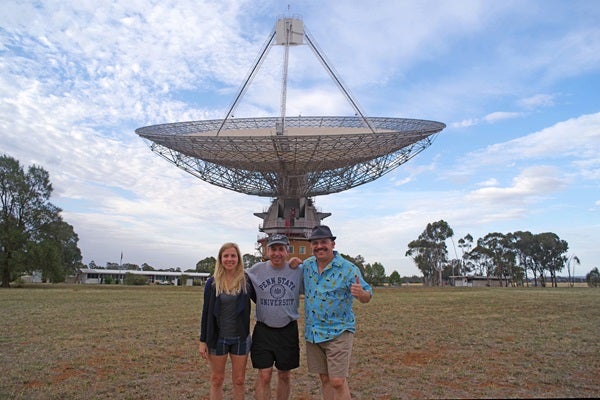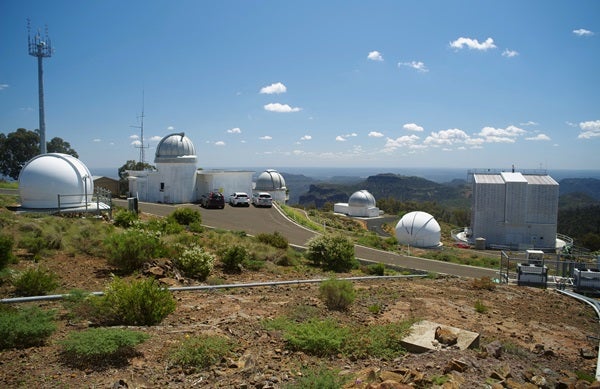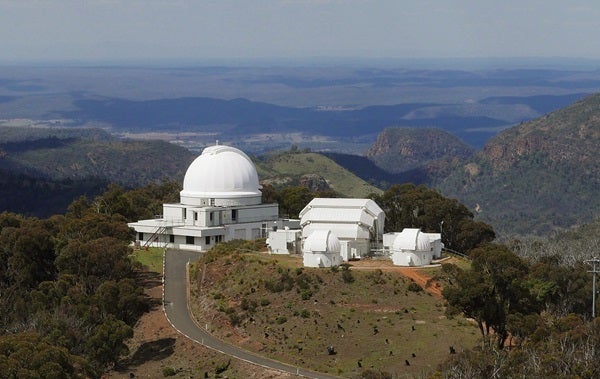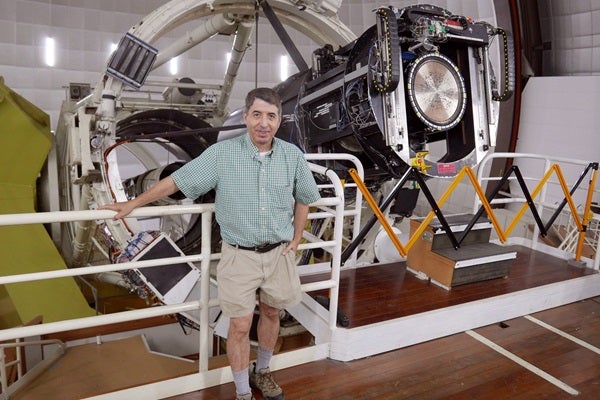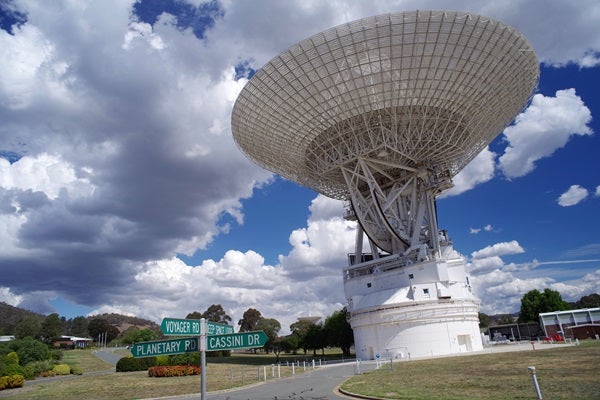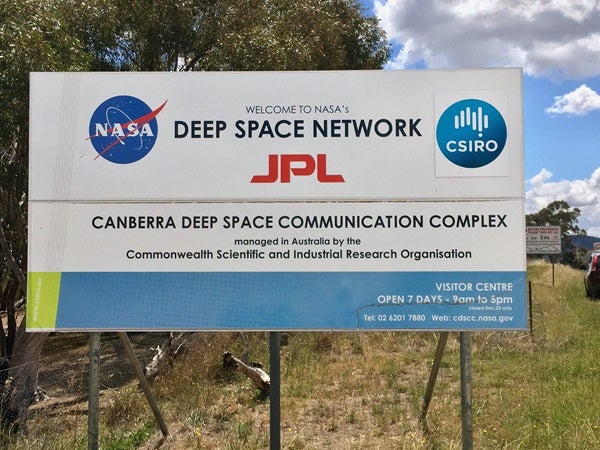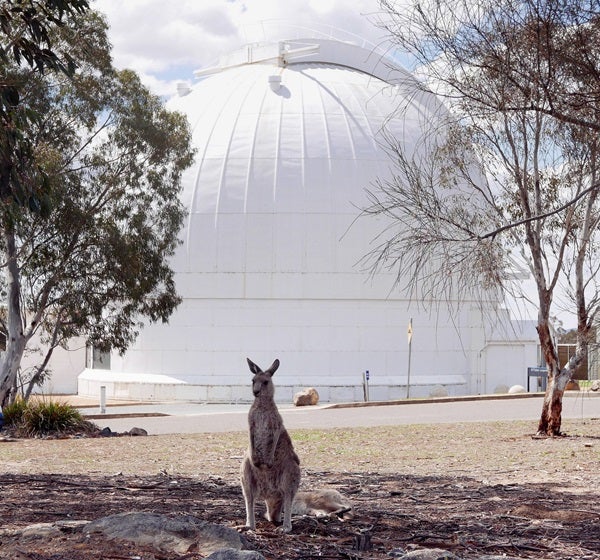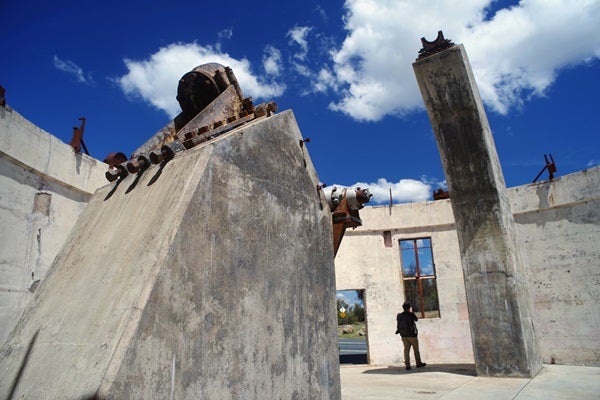An added draw, of course, was the night sky. I’ll never forget the view of the southern sky that I had from some of these sites, with velvety-black darkness, faint stars visible down to the horizon, and hardly a trace of light pollution.
First, a tip: If you tour the Australian countryside in November, as I did, be prepared for the flies — endless swarms of relentlessly buzzing flies like you’ve never seen, especially in the evenings. With that one caveat out of the way, I turn to the good news: Australia is an incredible country full of extraordinary scenery and numerous sites to thrill any astronomy enthusiast, including world-class optical and radio telescopes — and kangaroos to boot!
The Australia Telescope Compact Array
Why settle for one telescope when you can have six? That’s the idea behind the Australia Telescope Compact Array, located some 16 miles (25 km) west of Narrabri, NSW, and a solid six-hour drive from Sydney. We stayed overnight at Quirindi along the way. Each of the six identical 22-meter antennas weighs as much as a fully laden Boeing 747, yet can be moved with relative ease along a 2-mile (3.2 km) stretch of wide-gauge railway track — though only at the modest speed of 2.5 mph (4 km/h). It’s the largest centimeter-wave telescope array in the Southern Hemisphere, capable of detecting signals from deep space as weak as a hundredth of a trillionth of a watt.
As interesting as the telescope array is, a return visit later that night turned out to be even more memorable. Talk about a dark sky! I didn’t have to search for the Magellanic Clouds (the Milky Way’s small companion galaxies); I simply looked up, and there they were.
Also beaming down on us were Canopus and Achernar, bright stars that are never visible back home in Canada, along with a plethora of southern constellations. (And, mercifully, the flies were less bothersome at night.) The only catch is that in November, neither the Milky Way nor the Southern Cross is especially prominent in the evening sky. If I’m lucky enough to return sometime, I’ll aim for March or April, when it’s early autumn in Australia and the Milky Way arches overhead.
Siding Spring Observatory
Narrabri was as far north as our tour took us; next we drove southwest and in a bit less than two hours reached Coonabarabran, home to Siding Spring Observatory. The site is something like the Kitt Peak of Australia, in that it’s home to not just one or two telescopes, but a vast array of them. In fact, the hilltop location on the summit of Mount Woorut boasts some 50 astronomical research facilities.
White domes of all shapes and sizes pepper the site. Among them is the 154-inch (3.9 m) Anglo-Australian Telescope, the country’s largest optical telescope. Other major instruments include the 91-inch (2.3 m) Advanced Technology Telescope, the 49-inch (1.24 m) U.K. Schmidt Telescope, and the fully automated 53-inch (1.35 m) SkyMapper telescope. SkyMapper is charting the entire southern sky, complementing the equivalent mapping of the northern sky by the Sloan Digital Sky Survey.
Parkes Observatory
Of all the places we visited, Parkes Observatory was the true jewel. In addition to being a world-class astronomical facility, it’s also a stunning architectural and engineering achievement. It’s one of the few telescopes that’s instantly recognizable in photos. Parkes has even starred on the big screen, with a central role in the 2000 movie The Dish, which tells the story of the Parkes telescope’s role in tracking the Apollo 11 mission a half-century ago.
The actual antenna, the giant 210-foot (64 m) “dish,” is visible from miles away. Built in 1961, it was at the time the largest fully steerable radio telescope in the Southern Hemisphere — and today is superseded only by the 70-meter dish at Tidbinbilla (which awaited us at our next stop). Thanks to a series of upgrades over the years, the telescope is now some 10,000 times more sensitive than it was back in the ’60s, and it continues its groundbreaking science.
“There are a lot of very angry gallahs up there,” she said, referring to the ubiquitous pink-colored cockatoo. “When you tip the dish down to the horizon, they get upset.”
The whole shebang — weighing 1,000 metric tons — rests delicately atop the elegant circular brickwork of the central building, which is dubbed “the tower” even though it’s dwarfed by the gigantic dish above it.
Parkes is responsible for a string of important astronomical discoveries. It was the first telescope to detect the Magellanic Stream, a wispy trail of gas extending through the Magellanic Clouds and stretching across half the sky. Astronomers think the stream formed as a result of our own galaxy’s gravitational tug on the Magellanic Clouds over hundreds of millions of years. In 2007, the telescope made the first detection of a fast radio burst (FRB), a mysterious burst of energy from deep space. More than 30 FRBs have since been recorded, most of them by the Parkes dish.
At Parkes, we were privileged to have a behind-the-scenes tour, including a visit inside the telescope’s control room. While many of the instruments are distinctly modern, some of the control panels and hardware reflect the facility’s half-century-plus history.
“You can see the old paneling, the old labeling that people have used, that have long since peeled off or turned yellow,” Kaczmarek said. She mentioned how she recently opened a cupboard and discovered documents from the 1960s. “And it kind of instantly hits you in the face and reminds you, ‘I work in a piece of history.’ ”
The Canberra Deep Space Communication Complex
While most of the observatories we visited collect data from the depths of space, the Canberra Deep Space Communication Complex (CDSCC) generally tracks objects much closer to home — namely the many robotic spacecraft currently exploring the solar system. The complex, located near Tidbinbilla, about 10 miles (16 km) southwest of Canberra, was established in the mid-1960s.
Today it’s home to five large antennas — the enormous 70-meter dish, known as DSS-43 (or Deep Space Station 43), and four still-impressive 34-meter dishes. DSS-43 was originally a 64-meter instrument — the same size as Parkes — but was extended by 6 meters in 1987, making it the hemisphere’s biggest. It stands as high as a 22-story building.
Mount Stromlo Observatory
Mount Stromlo Observatory, just a 20-minute drive from downtown Canberra, is the most urban of the astronomy sites we visited, but also one of the most interesting. Founded in 1928, the facility is steeped in history but was tragically devastated by a wildfire in 2003. The blaze destroyed five telescopes and several historic buildings. After a herculean restoration effort, the observatory reopened in 2015. Still, the ruins of once-great telescopes and the buildings that housed them are a poignant sight.
The dome of the 74-inch (1.9 m) reflector — formerly one of Australia’s great telescopes — still stands, though the telescope inside is in ruins. (You can glimpse its remains through the windows.) The Yale-Columbia 26-inch (66 cm) refractor, dating from 1925, fared even worse: Even the dome was destroyed, leaving only a circular foundation and part of the concrete mount where the historic instrument once stood.
After a daytime tour of the site, we returned in the evening to take photos. As dusk fell, we were joined by dozens of kangaroos, munching on the grass and not seeming to mind a few human intruders. When it got dark, I could no longer see my marsupial friends — but I could hear them hopping around me as I set up my camera and tripod to take time-exposure photographs. As evening gave way to night, and Alpha and Beta Centauri skimmed above the southern horizon, I thought, “I could definitely get used to this.”

